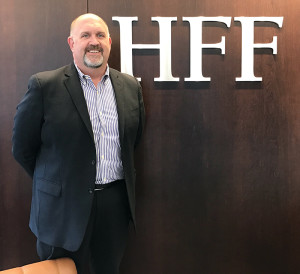 Now entering his 10th year with HFF, and back in New York where he’s settling into his new digs at the firm’s office in Rockefeller Plaza, Senior Managing Director Daniel C. Peek is the leader of HFF’s hospitality practice group, focusing primarily on institutional-grade hotel and resort property transactions throughout North America, Latin America and the Caribbean. During his career, Peek has completed nearly $12 billion in investment sale, debt and equity-placement transactions.
Now entering his 10th year with HFF, and back in New York where he’s settling into his new digs at the firm’s office in Rockefeller Plaza, Senior Managing Director Daniel C. Peek is the leader of HFF’s hospitality practice group, focusing primarily on institutional-grade hotel and resort property transactions throughout North America, Latin America and the Caribbean. During his career, Peek has completed nearly $12 billion in investment sale, debt and equity-placement transactions.
Previous to HFF, Peek was a co-founder and managing director of Regent Street, an affiliate of The Plasencia Group, Inc., where he also served as SVP, handling hotel and resort property transactions in the Northeast, Mid-Atlantic and Southeast. And before that, he worked in hotel operations and consulting, including a variety of management positions with Marriott International and Winegardner & Hammons, and later as a consultant with HVS International in New York.
A graduate of Cornell University, Peek has worked with clients Apollo Global Management, ARES Management, Blackstone Group, GE Asset Management and HEI Hotels & Resorts.
How would you characterize the transactions market in 2016 and what can we expect to see this year? I’d describe 2016 as an interesting year. [Fewer] headline-grabbing transactions in our gateway markets, which has hampered overall transaction volume, but generally good liquidity in the balance of the country. Choppiness in the CMBS market in Q1 certainly had an impact given the sector’s historical reliance on CMBS as a major financing source. That said, CMBS is back, and banks—both regional and national—and debt funds expanded their presence and helped complete many transactions.
There’s potential for 2017 to be a strong transaction year. It might start slower but grow as the year progresses. A lot of would-be sellers played “wait and see” with the election, the economy and conditions in the capital markets. What do you expect will be driving that activity? Lots of potential drivers on the sell and buy sides going into 2017. Maturing loans are one factor, along with the recycling of investments made earlier this cycle by funds with finite hold periods. Many of the latter don’t have to sell, but would like to if the market is solid. On the buy side, there remains a lot of equity in the space, both domestic and foreign, that is motivated to invest in attractive hotel assets.
Who’s got the upper hand (if anyone) at the start of 2017: buyers or sellers? The pendulum has swung a bit in the buyers’ direction of late, but the market is better than many assume and there are very few sellers who “need” to sell. The upper hand, so to speak, is much more prevalent when there is pressure to sell or a shortage of assets on the market. I expect we will be closer to equilibrium in 2017.
What do you think will happen now that the Federal Reserve in December raised interest rates as anticipated? Most market participants have a few Fed Fund rate increases baked into their analysis. This should not be a major impact. The recent move out in treasuries, post-election, will have a more significant impact relative to the fixed-rate financing market.
What hotel segments do you expect will exhibit the greatest churn? We’ll see continued selling in the secondary markets for sure. Larger select-service portfolio owners will continue to prune their portfolios. It remains to be seen if transaction volume in the gateway markets will pick up.
How would you characterize valuations as we move into 2017? Cash flow will remain king. Pricing is much more driven by short-term yields than it was earlier in the cycle. Great value-add and gateway hotels will still see lower cap rates but, generally speaking, they will be stable or up a bit. Key determining factors for pricing are the cost of capital (per the previous interest-rate comments) and the local demand and supply dynamics. Some markets have stronger growth in the short term—Southern California, Texas outside of Houston, and Florida are good examples—while others may have more supply that hampers growth expectations. To paraphrase Tip O’Neill, all real estate is local.
What do you see people coming to buy/invest in? I think the appetite remains broad. In looking at our business in recent months, opportunity funds have ventured into secondary markets for what they see as better investment dynamics and greater value-add executions. Foreign capital continues to pursue the gateway markets, but we’ve seen transactions completed of late with Asian and Middle Eastern investors in the top 25 markets and beyond. Smaller firms and investors are raising their game as they mature, as is always the case. The big-name funds weren’t always so big. There’s a lot of growth yet to occur among the universe of hotel investors, which is as diverse as ever.
How effective do you feel the online real estate marketplace is? Are traditional brokers embracing it? The online marketplace is evolving and gaining some traction, particularly in the smaller asset market, and particularly among sellers who need to clear a given asset at whatever the market will bear. It has been embraced to a degree where there is mutual value-add. That said, investment decisions are still very nuanced. The traditional marketing process can and does yield a more holistic response on which investors and owners can make informed decisions.
Words of advice to buyers, sellers or investors for 2017? Think critically. The market is complex and the opportunities and market responses to opportunities based on product and market can vary greatly. And be patient. As we are later in the cycle, getting to the right deal execution can take time, but we have seen patience be rewarded time and time again in 2016. HB

